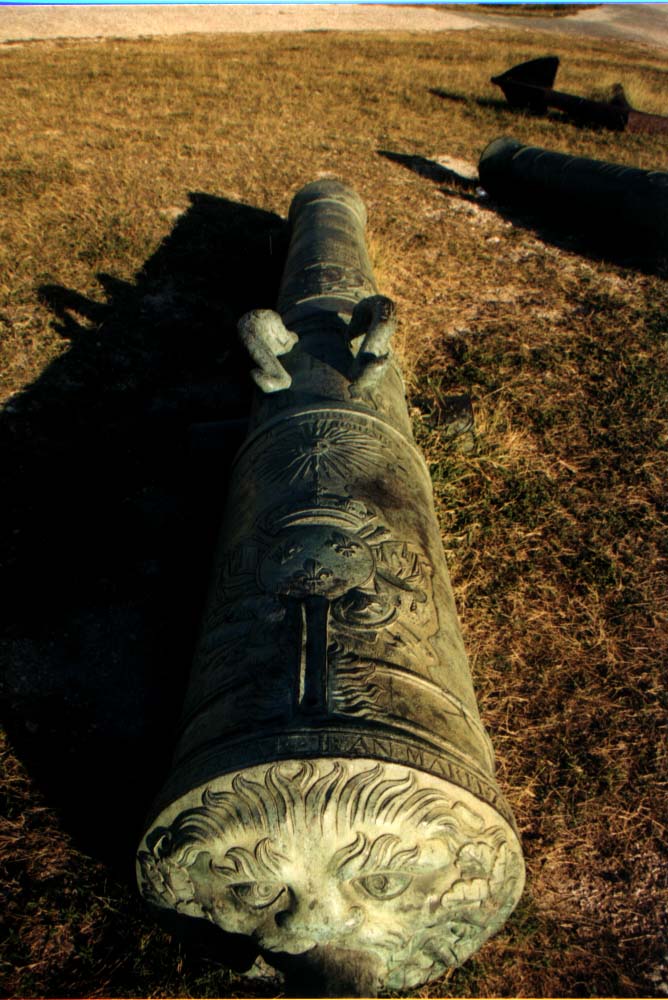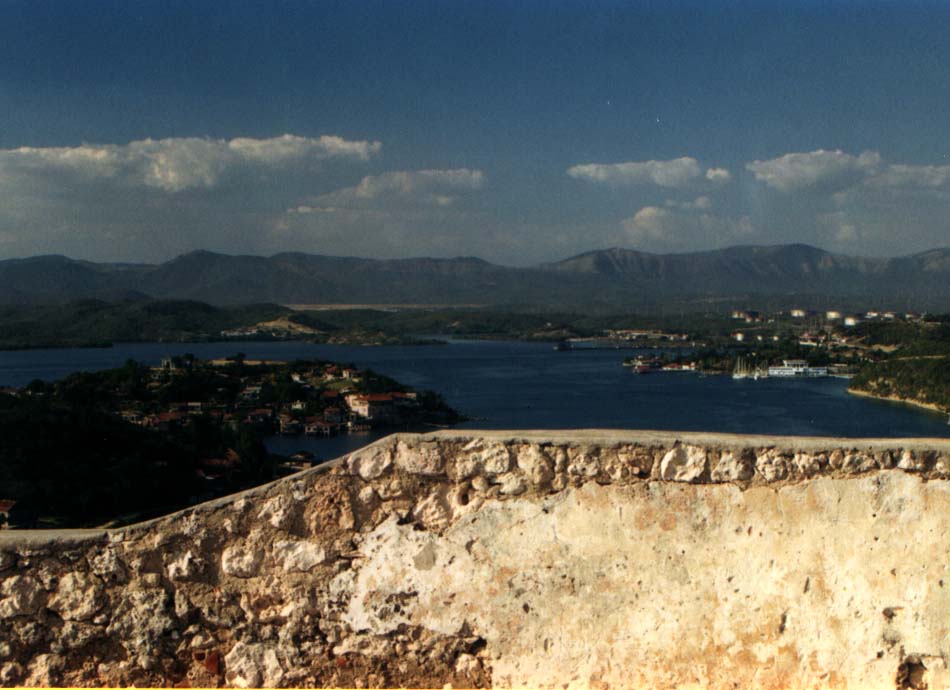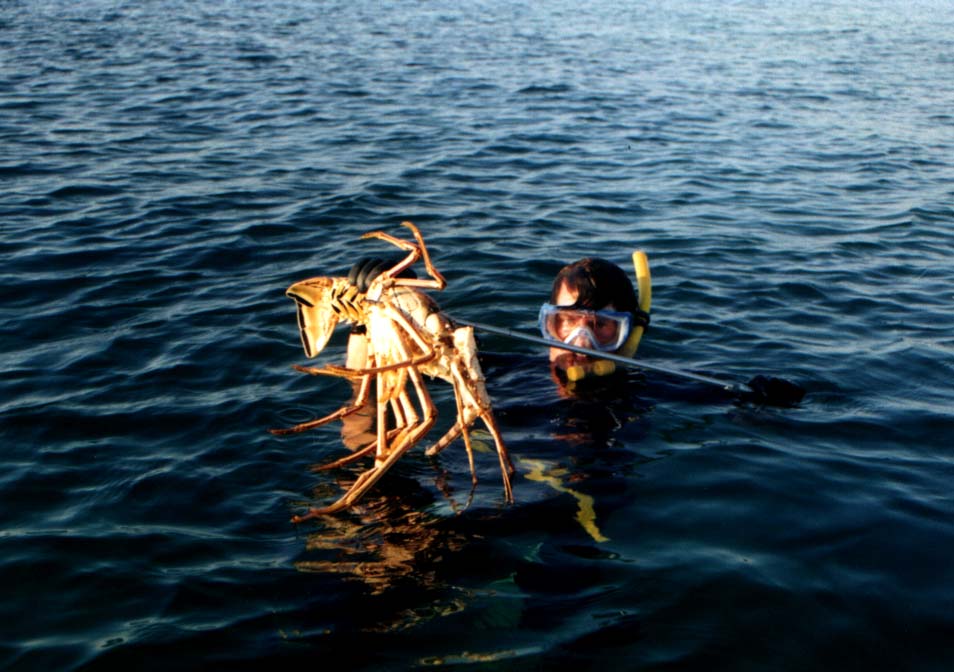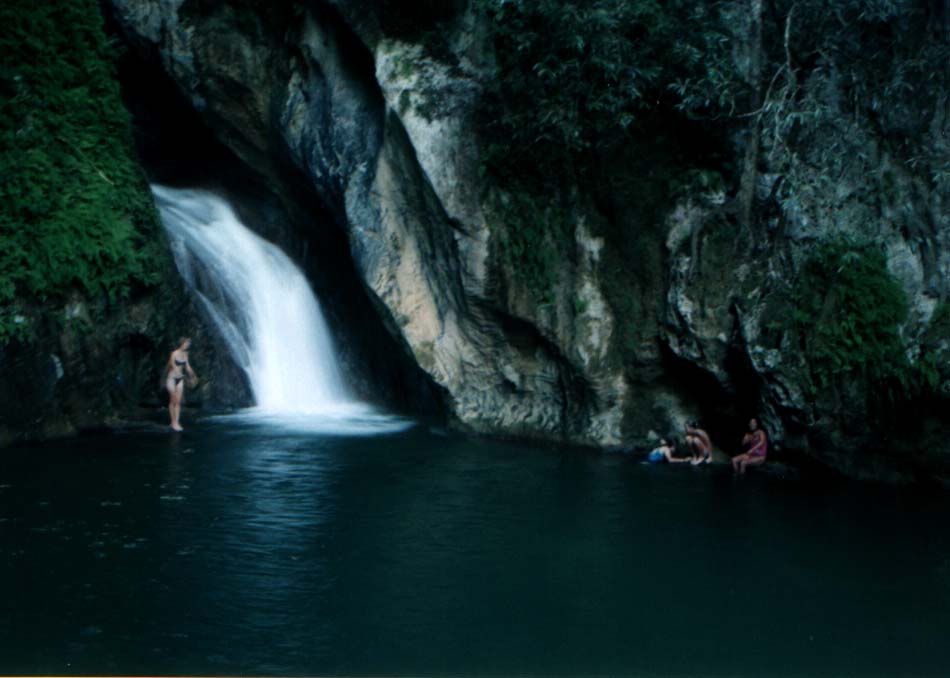
Cruising the Northwest Caribbean
“Oh, Won’t You Stay - Just a Little Bit Longer”
By Barbara Theisen
Out of Bounds was flying across the water just 15 miles off the south shores of Cuba. It was about 11 PM and I was at the helm watching the knotmeter climb above 9 knots. We only had a handkerchief-sized foresail up and the mainsail had been double reefed. The waves were minimal and the ride was comfortable – except we were going so darn fast! I know, technically I could be riding my bike at a faster speed, but in our sailboat, 9 knots is fast! I could see the lights twinkling on shore and overhead a clear sky was filled with stars.
 |
| Ornate cannon at El Morro Castle. |
We had left Great Inagua, the southernmost island of the Bahamas, at daylight and headed across the Old Bahama Channel towards the Windward Passage. By lunchtime we could see the distant mountains of Cuba.
At sunset we were entering the Windward Passage, a 45-mile wide passage between the islands of Cuba to the west and Hispaniola to the east. It had been a good sail with Out of Bounds averaging about 5 knots. But once the sun went down, the breeze came up and now I was wondering where the brakes were.
When our watch was over, my 13-year-old daughter Kenna and I went below to sleep and my husband Tom and 13-year-old daughter Kate took over the midnight to 5 AM watch. Before I knew it I was back up in the cockpit, sunrise illuminating the green mountains of Cuba. It was gorgeous!
We had thought about canceling our plans to visit Cuba when we heard reports over the SSB radio from two Canadian cruising sailboats. They said they had been having trouble with officials in the Cuban port of Marea del Portillo – just west of Santiago.
The first report indicated that they were being guarded by officials on a gunboat and that they were unable to leave their boats. A few days later the two boats left Cuba and headed to Jamaica. It seemed to us that these boats made this incident into way more than it really was. We discovered that they had been denied access to shore at this particular port. Not totally unreasonable. When you visit a foreign country, you need to be able to follow their rules and regulations. In a country such as Cuba, you best remain flexible in regards to what their rules and regulations might be. However, these boats insisted that because they had tourist visas that they should have permission to go wherever they pleased! Not a good way to make friends with officials.
We decided to check into Cuba at Santiago de Cuba, the first official port of entry we would be coming to. By mid afternoon Out of Bounds was outside the entrance to the harbor. Above us, the formidable El Castillo Morro guarded the narrow harbor entrance.
We requested permission to enter the country and were told over the VHF to enter the harbor and proceed towards the marina, where we would anchor and await boarding by officials.
Soon a steel gray gunboat came alongside and a steady stream of officials came aboard. Out of Bounds was filled with about a dozen officials from Customs, Immigration, the Cuban Coast Guard, the Health Inspector and the Port Captain. All of the officials were polite and respectful. The boat was thoroughly searched, but someone from Out of Bounds was always asked to be present as the officials opened drawers, cabinets, etc. Paperwork was filled out, cokes were passed around and jokes were made about our gato gordo (fat cat). We have two cats aboard and indeed one of them had been dining on freshly caught fish a bit too often. Then the gunboat returned and whisked the officials away. Beinvenidos a Cuba!
Our friends aboard the S/V Poppy - Paul, Lee, Jessie and Vicki had arrived several days earlier. They had sailed straight through from Conception Island in the Bahamas, while we had made several stops along the way and waited for better weather.
 |
| Harbor at Santiago de Cuba with marina in the background. |
Together the next day we explored Cuba’s second largest city. Diego de Velazquez founded Santiago de Cuba in 1514. Hernan Cortes was the first mayor. Lovely colonial buildings still grace parts of the city.
For such a large city it seemed strange to see almost no private cars on the streets. Buses, crammed with people, belched diesel fumes. Motorcycles with sidecars were parked on the street and bicycles, often with one peddler and one or two passengers, whizzed by. Horse drawn carts carried produce to market.
 |
| Tom spears another lobster. |
In the cool shade of the Parque Cespedes we listened to street musicians. We walked down streets filled with vendors selling their crafts.
At El Morro Castle, which sits high atop a cliff overlooking the Caribbean Sea, we explored this fortress built between 1633 and 1693. The walls of the fort are several feet thick. The girls were thrilled to see the three dungeons. We strolled by the lighthouse that was built in 1898 after Americans destroyed the original light during the Spanish-American War.
 |
| Kenna, friend Jessie and Kate take a break from exploring the colonial town of Trinidad. |
We had hoped to hop from port to port along the south shore of Cuba over the next week or two and then proceed west towards the Bay Islands of Honduras. We soon realized we would need to devise a new plan. Officials in Marea del Portilla were still upset about the incident with the Canadian boats. We would be unable to visit any of the ports between Santiago and Cabo Cruz, which was located on the southwest point of Cuba. And we would not be able to clear out of Cuba at Cabo Cruz, as it was not an international port. In fact, although we would be allowed to stop at Cabo Cruz, we would not be allowed to go ashore there.
Armed with their Lonely Planet Guide to Cuba and a National Geographic magazine with an article about Trinidad, Cuba, our friends aboard Poppy soon convinced us to accompany them to the port of Casilda and the nearby town of Trinidad. At Casilda, we were told, we would be able to receive our departure papers. Although this would take us back to the north we would still have a nice run to the Cayman Islands and then on to Honduras.
We departed Santiago, after clearing out with officials. The sail along the coast of Cuba was one of spectacular beauty. Off our starboard side the Sierra Maestra Mountains rose to a height of 1,972 meters. The sea beneath us fell even more dramatically (or so we were told). It dropped to depths of 7,239 meters making the change in elevation here – from the mountain peaks to the ocean depths – the greatest, in the shortest distance, of anywhere on earth.
 |
| The girls take a dip in the pool beneath the waterfall in the Escambray Mountains. |
We sailed, in company with Poppy, into an unforgettable sunset and watched night descend upon the Caribbean Sea.
The next afternoon we arrived in the small town of Cabo Cruz where two officials were brought out to our boat by the captain of a local fishing vessel. They were dropped off with their small rowing dinghy. Formalities were brief - our papers needed to be checked, we were told that we could snorkel on the reef but that we could not visit town and we were told we would need to check back with the officials before we could depart. There was a brief check of our boat – seemingly more because they were interested in seeing some of our things such as books, magazines, electronics, TV, provisions, etc – then because they thought they might find contraband. When the officials got in their dinghy to row the mile or so back to town, Tom offered them a ride in our inflatable with outboard. He dropped them off at the town dock but was immediately told he would have to return to the anchorage. He could not go ashore.
We immediately got out our snorkeling gear and headed to the reef to find relief from the heat. Back on the boat a few hours later we heard a knock. Strange, we hadn’t heard a boat approaching. We went topside and saw nothing. Then we heard the knock again. I looked down and there were three Cuban teenagers in snorkeling gear, one holding a long spear. They were towing a huge Red Snapper and several lobsters. “Would you like to trade a baseball cap or toothpaste for some fish and lobster?” one of the boys asked in Spanish. We wrapped up a baseball cap, some toothpaste and some soap in a plastic bag for them. There was no boat in sight. They must have swum at least a mile out to our boat!
We spent the next week or so exploring an uninhabited area of Cuba called Archipelago de los Jardines de la Reina or Queen’s Gardens, a collection of cays stretching northwestward anywhere from 25 to 45 miles off the mainland. We saw no sign of human life except for an occasional fishing boat. We had permission to visit any of these cays and we wouldn’t have to check in with any officials – as there were none. We ate lobster dinners most every night and when I started serving it at lunch, as well, I was greeted with a chorus of “Oh no. Not lobster again, mom!” Fortunately the fishing was great too and we were able to enjoy fresh wahoo and grouper dinners as well. Poppy and Out of Bounds shared this tranquil paradise. We hadn’t seen another sailboat since Santiago de Cuba.
We sailed on to Trinidad and back to civilization. Our guidebook said to “avoid going in to Casilda (the official port town - as Trinidad lies several miles inland) on a Sunday like the plague.” Then we realized that it was Sunday! Our book said the guarda frontera and customs were very slow on Sundays. We envisioned waiting for hours to start our paperwork. But as soon as we anchored we saw the guarda waving to us from shore. Tom dropped the dinghy in the water and went in and returned shortly with the port captain. All of the officials that we encountered in Cuba were friendly but this young man bubbled over with enthusiasm. He was so proud of Trinidad and so excited that we had come to visit his hometown. Our paperwork was done in about two minutes.
 |
| Dinghy sailing in Cienfuegos. |
We told the port captain that in a few days we would want to obtain our clearance papers to depart the country. We knew we needed to give the Cuban officials several days notice to prepare our paperwork. We were told that Casilda is no longer an international port and that we would have to sail on to Cienfuegos to get our papers. Oh well, we were enjoying Cuba immensely. We would stay a little longer. Eventually we’d find a port that would let us leave the country.
We had a choice of staying at a marina across the bay or anchoring near it. We choose to anchor out where we could enjoy a cool breeze. That night we saw the constellation Southern Cross for the first time.
Near the anchorage and marina was a large resort called the Ancon Hotel, catering mostly to Europeans looking for warm, sunny beaches and great scuba diving. We discovered university professors, engineers, and other educated professionals that had become taxi drivers or chefs at the resort – all in hopes of earning tips in US dollars. The US dollar has become the real currency of Cuba, as their peso was basically worthless.
A few miles inland lays Trinidad, a 500-year-old colonial town that made its money in the late 18th century from sugar. Today it is a UNESCO World Heritage Site. The red-tiled roofs and narrow cobblestone streets of the town make it one of the most delightful towns I have ever seen. We enjoyed visiting several museums and churches including the oldest church in Trinidad, Nuestra Senora de La Candelaria de La Popa, which was built in the early 1700’s. We had drinks at an old sugar warehouse that had been converted into a café.
One day we went up into the Sierra del Escambray Mountains to a small resort town where we hiked to a waterfall. We spent an hour or so hiking down into a valley where we found the falls and a pristine pool. The four girls went swimming in the ice cold water but it was a bit too nippy for the adults.
Our next stop was at the large port city of Cienfuegos where we docked at the marina. After a morning of homeschool and hand washing the laundry, we took a horse drawn “wagon” into town. We spent the day exploring the city. In stark contrast to Santiago, we saw cars whizzing by on the wide boulevards. There was a strange combination of big Buicks and Chevys, mostly 1940’s and 1950’s vintage, along with tiny Russian built cars from the 1980’s.
While sailing to Cienfuegos we stripped a gear on our autopilot. We would need a small nylon cog mated to a larger brass cog to repair it. In the meantime we would have to revert back to hand steering, not a problem when day sailing but not such an exciting proposition when it came time to head offshore for several days.
Without an autopilot, we decided to continue north and cross over to Isla Mujeres, Mexico – a short hop of only 24 hours or so, rather than sail the four or five days to the Bay Islands of Honduras. That way we’d get to see a bit more of Cuba. Who would have guessed that we’d have such a hard time leaving!
After spending a glorious month “buddy boating” with our good friends on Poppy, it was time to go our separate ways. Poppy was heading straight from Cinefuegos to the Panama Canal in a few days. We were going to continue northwest and explore a few more Cuban cays before heading to Mexico.
Back out in the Caribbean, we caught several barracudas on our handlines, before finally catching a nice wahoo. But as we pulled him in, someone took a big bite and we were left with only half a wahoo. We cut him up into cat food.
Our first night back in the cays, we anchored in the lee of a little island. There wasn’t a breath of wind to cool us off so naturally we headed into the water. We snorkeled over a gorgeous reef filled with incredible sea fans, brain coral formations and more. Starfish were abundant. That night our flat calm anchorage was hit by a sudden squall that lasted until the wee hours of the morning. The boat was pitching up and down in the step chop. It was useless to try to sleep. Fortunately the anchor held tight and by sunrise the seas were calming down.
We spent the next week snorkeling and enjoying great sailing as we headed towards the tiny resort of Maria La Gorda. Although it is an international port and we would be able to check out of Cuba here, Maria La Gorda is really just a dive resort. Officials have to drive five hours from the nearest town to check boats in and out. The diving is said to be superb, but you’re not allowed to dive without hiring a guide.
We eased Out of Bounds up to the dock in front of the resort’s cabanas. A sandy beach lined with graceful palm trees stretched for miles down the coast. The water was the clear, turquoise blue we had grown so accustomed to yet would never grow tired of. We saw the officials walking down the dock. It was time to say good-bye to this lovely country.
We found the people of Cuba to be some of the friendliest people we have ever met. Never have I seen people who have so little and yet are so content with what they do have. Sailing behind the sugar curtain is not for everyone. But if you have an open mind, enjoy getting off the beaten path, have an adventuresome spirit and can remain flexible then Cuba can offer some of the best cruising in the entire Caribbean. With uncrowded anchorages, spectacular scenery, some of the oldest towns in the New World, amazing reefs for snorkeling and diving, and a growing number of marinas and resorts, Cuba may well become one of the hottest cruising destinations around.
We had planned on staying only a short time in Cuba. But we’ll always be glad we kept exploring more and more of this fascinating country.
Barbara Theisen has spent the past ten years living aboard Out of Bounds with her husband Tom and daughters, Kate and Kenna. For more information on living the cruising life visit the Theisen’s Website at
www.TheCruisingLife.com.